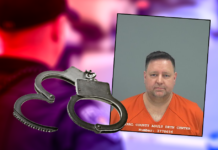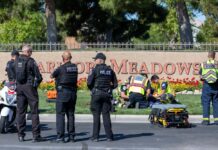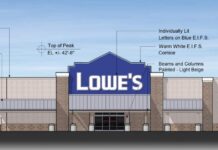
By Raquel Hendrickson
An overpass is one of the most certain elements on the Maricopa Area Transportation Plan.
Its purpose of improving traffic flow through the city could be the impetus for creating three northbound lanes from Smith-Enke Road to the Rancho El Dorado entry. It could also be the lure for bringing the proposed Interstate 11 closer to Maricopa.
It is a stable point in the city’s draft Transportation Master Plan, which is filled with projects to improve how Maricopans will get around for the next 25 years.
Some proposals, however, have a lot of question marks, though they continue to appear on planning maps. Developers Seth Keeler and Scott Cole are not happy about that.
Both have pending developments in the crosshairs of some of the transportation improvement ideas. Some red-flagging is in order, from their perspective, as Phase 1 moves forward. The draft was presented to the Maricopa City Council Aug. 4 after an open house.
The overpass on John Wayne Parkway across Union Pacific Railroad tracks has long been a darling for planners and now has a promise of state funding in five years. It will contribute to a goal of the transportation portion of Maricopa’s 2040 Vision: “Create an adequate intra-city road network.”
Another grade separation across the UPRR tracks at the junction of Maricopa-Casa Grande Highway and White & Parker Road is proposed for the far more distant future. The idea was introduced in 2010.
The plan is to tie that grade separation into the proposed East-West Corridor by extending Farrell Road on the west side of the railroad tracks.
Cole represents the Santa Cruz Ranch project, which is in an unincorporated area adjacent to the city limits. The new corridor would run through his property.
He has voiced his complaints to the city council more than once about the proposed road placement. Cole Enterprises has an agreement with Pinal County about just that kind of situation.
“We cannot be required to put roads in Santa Cruz Ranch,” he said at a meeting for developers to look at the draft transportation plan. “We’ve said this at every meeting like this. That public comment never shows up anywhere. We never get any feedback.”
Transportation and Transit Director David Maestas emphasized it is a preliminary draft of the area transportation plan. Geographical and hydrological features in the area are dictating the placement of that corridor so far. In particular, Santa Rosa Wash plays a part in all movement in that area.
Dan Marum, transportation planning manager for Wilson & Company, the city’s consultant, said the corridor ideas are basic and simply lines on a map rather than written in stone at this stage.
“It’s not just a line on a map,” Cole countered. “If I hear that again I’ll go crazy.”
Keeler requested a red box be placed on the proposed maps to indicate a problem area as a reminder to all planners.
Keeler, who represents W Holdings in Tempe, also has a point of contention with the proposed alignment of Farrell Road. On project maps, it would cut southwest through his property before connecting to State Route 347.
He brought up his dissatisfaction with that proposal during the first Developer Outreach Forum the city’s transportation planners hosted in April. So he was surprised to see the same configuration at the second meeting in July.
“It looks like everything we told staff hasn’t been taken into account,” Keeler said.
Maestas described the current alignment of Farrell Road as a “fatal flaw” in the effort to make it a four-lane corridor because it would impact land belonging to the Ak-Chin Indian Community. That, he said, is why the alternative is to angle it south.
Marum said Phase 1 of the Transportation Master Plan was to find ideas to deal with needs, not agreements. “In Phase 2, we’ll be planning alternatives that can address those concerns,” he said.
While Maricopa has challenges on Farrell Road, its more immediate attention is on State routes 347 and 238. The Arizona Department of Transportation has shown little interest in widening SR 347 to six lanes and there is a local push to find another route to Interstate 10, but Marum has faith improvements can be made to the 347 traveling experience.
“We want to avoid the stigma that 347 is broken,” he said. “We have a small window to get out in front of that.”
Maricopa Area Transportation Plan
• Phase 1 – Transportation Master Plan, Regional Connectivity Plan
• Phase 2 – Plan Implementation Support
• Projected population in 2040: 138,000
• Projected population at total build-out: 600,000
Regional Connectivity Plan Goals & Objectives
• Update transportation planning framework to support City development patterns and those of surrounding communities
• Examine roadway network to assure functions match community growth and needed regional connections
• Plan for multimodal connections to surrounding communities
• Provide long-term guidance on right-of-way requirements for regional facilities





![Affordable apartments planned near ‘Restaurant Row’ A blue square highlights the area of the proposed affordable housing development and "Restaurant Row" sitting south of city hall and the Maricopa Police Department. Preliminary architectural drawings were not yet available. [City of Maricopa]](https://www.inmaricopa.com/wp-content/uploads/2024/04/041724-affordable-housing-project-restaurant-row-218x150.jpg)












![Affordable apartments planned near ‘Restaurant Row’ A blue square highlights the area of the proposed affordable housing development and "Restaurant Row" sitting south of city hall and the Maricopa Police Department. Preliminary architectural drawings were not yet available. [City of Maricopa]](https://www.inmaricopa.com/wp-content/uploads/2024/04/041724-affordable-housing-project-restaurant-row-100x70.jpg)


